History of Hillel
Over the past century, Hillel has grown into the largest and most inclusive Jewish campus organization in the world. Founded in 1923, the Hillel movement has grown and evolved for 100 years. This is our story.
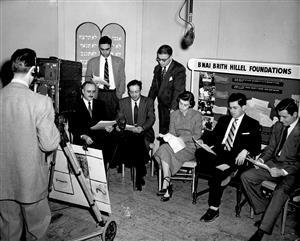
Hillel Through the Years
These black-and-white images hold some of our favorite memories.
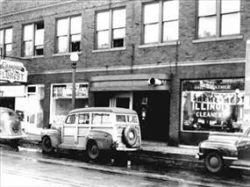
1923
Benjamin Frankel opens the first Hillel at the University of Illinois, Urbana-Champaign.
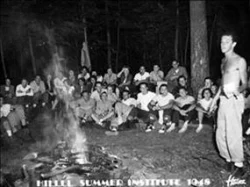
1948
Hillel organizes the third summer institute to engage more students and professionals.
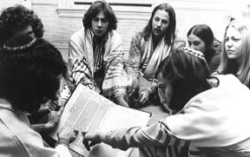
1970
Students study a portion of the Talmud, an extensive collection of Jewish laws and traditions.
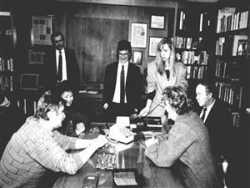
1988
Hillel facilitates a call between former refuseniks and their families in the Soviet Union.
1923
Hillel begins with a noble mission, and a breathtaking vision: to convey Jewish civilization to a new generation. Upon graduating from rabbinical school in 1923, Rabbi Benjamin Frankel accepts a part-time pulpit with a congregation in Champaign, Illinois, under the condition that he could continue to work with college students. Fundraising efforts begin to turn Frankel’s part-time program into a full-time organization, and the first Hillel opens at the University of Illinois, Urbana-Champaign.
1924
Norman De Nosaquo, a Jewish student at the University of Wisconsin, writes a letter to the editor praising the creation of Hillel at the University of Illinois and arguing for the creation of a similar group at the University of Wisconsin. A few months later, Hillel at the University of Wisconsin, Madison is founded.
1925
B’nai B’rith President Adolf Kraus notes, “I believe that foundations such as those now existing at the University of Illinois and at the University of Wisconsin should be extended into all universities and schools for higher education, in which suitable provision is not made for Jewish students, to encourage the cultivation of their Judaism.”
1937
Dr. Lee Levinger releases The Jewish Student in America” (PDF file), featuring statistics and analysis of the 1935 study of Jewish student enrollment in 1,400 institutions of higher learning in the United States.
1939
With 12 full-fledged Foundations in operation, Hillel announces a major program to create “Hillel Extension Units” on 18 campuses with smaller Jewish populations. National Jewish Monthly, November 1939 (PDF file)
1944
In The B’nai B’rith Hillel Foundations – Retrospect and Prospect” (PDF file), Ohio State University Hillel Director Harry Kaplan discusses Hillel’s role in the post-war era, including re-integrating veterans and combating campus antisemitism.
1945
Packed with photos, this 1945 Hillel brochure (PDF file) assesses Hillel’s accomplishments and future objectives. It notes that Hillel “operates on the principle that the patterns of Jewish life are important in the composite of western civilization, and that the university is enriched when it supplements the resources of the campus with the best in the Jewish tradition.”
1959
An excerpt from the National Jewish Monthly (PDF file) follows University of Pennsylvania student Joan Kaplan as she participates in Hillel activities.
Hillels, usually employing only one or two staff members, are deluged by waves of Baby Boomer students. Campuses that once hosted small Jewish populations become viable Jewish communities in need of Hillel Foundations.
1973
In the June 1973 National Jewish Monthly, Hillel pioneer Abram L. Sachar discusses the early history of the organization, a Hillel director describes the professional’s role on campus, a former student shares how his Hillel inspires him, and Hillel Executive Director Rabbi Alfred Jospe assesses contemporary students.
1974
Hillel marks its 50th anniversary with “The Test of Time” (PDF file), a compendium of essays on Hillel’s past, present, and future from prominent Hillel professionals and academics. Writers include Abram Sachar, Marvin Fox, and Philip. M. Klutznick.
1980s
College admission barriers to Jews drop in the postwar decades. During the 1980s, it is estimated that 80 percent of all Jewish college students attend 109 universities with Jewish student populations greater than 1,000 and that hundreds more campuses attract smaller Jewish student enrollments. Even at the apogee of B’nai B’rith’s strength, the sheer scope of the challenge to serve Jews on campus grows beyond its capacity. The organization is forced to cut its financial allocations to Hillel by 50 percent.
1988
B’nai B’rith hires Richard M. Joel, a 37-year-old attorney and Yeshiva University dean, to revitalize Hillel.
During the 1990s, Hillel splits from B’nai B’rith, renaming itself Hillel: The Foundation for Jewish Campus Life. It rebounds with unprecedented vigor. By the late 1990s, Hillel encompasses 120 foundations and 400 affiliates.
1994
Renowned Jewish leader Edgar M. Bronfman, chairman of the board of the Seagram Corporation and chair of the World Jewish Congress, becomes chair of the Hillel International Board of Governors.
1998
Under the energetic leadership of Richard Joel, Hillel wins support from major Jewish family foundations and local federations of Jewish philanthropy, both to build impressive new facilities and to underwrite new ventures. Hillel’s “Campaign for a Jewish Renaissance” raises $37.5 million in 1998 alone.
1999
Birthright Israel sends the first group of students to Israel on a free 10-day trip to strengthen their Jewish identities and connections to the state of Israel.
2002
Thousands of Hillel students pledge their solidarity with Israel on April 15, 2002 in Washington D.C., at the largest rally of its kind in the capital’s history.
2004
Hillel social justice drives result in the addition of over 4,600 new donors to the Gift of Life Bone Marrow Registry.
2008
Participating in Hillel’s Alternative Spring Break, students help to rebuild neighborhoods devastated by 2005’s Hurricane Katrina and further damaged by the 2008 hurricane season.
2011
Nearly 200 students from eight Hillel Centers across Israel assist the Carmel region in its recovery from the summer’s devastating wildfires.
2012
Craigslist founder and philanthropist Craig Newmark includes Hillel’s Ask Big Questions initiative on his list of “16 People and Organizations Changing the World in 2012.”
2013
Hillel International names former Congressman and Chancellor of the Ohio Board of Regents Eric D. Fingerhut as its new President and CEO.
2014
The Ezra Fellowship and Base Hillel programs are launched. Hillel Germany opens in Berlin.
2016
Actor and 2015 Genesis Prize winner Michael Douglas and head of the Jewish Agency for Israel, Nathan Sharanksy, visit three college campuses on a Hillel-sponsored speaking tour to talk about Judaism, Israel, and modern antisemitism. The Hillel Talent Grants and Springboard Fellowships are established, and HillelU is launched. Hillel Warsaw, the first-ever Hillel in Poland, opens on the 73rd anniversary of the Warsaw Ghetto Uprising.
2018
With input from the Hillel International Student Cabinet, Hillel launches MitzVote, a new initiative to inspire 100,000 students to vote in the 2018 midterm elections. The first cohort of Springboard Fellows graduates.
2020
Hillel International names Adam Lehman as its new president and CEO. Lehman, a successful executive and entrepreneur, previously served as chief operating officer and interim president and CEO of Hillel International.
Hillel@Home launches to provide high-quality virtual learning and community experiences to Jewish students amid the coronavirus pandemic. Hillels around the world also adapt their offerings for students in isolation, using online platforms to organize programs and provide to-go meals for students.
2022
Hillel International launches an Emergency Relief Fund to support five Hillels in Ukraine, as well as refugees sheltering at Hillels in Central Asia and Eastern Europe. In less than three weeks, the fund raises more than $1 million, helping provide food, shelter, water, medicine, and social services to hundreds of displaced Ukrainian Jews.
2023
Hillel celebrates its Centennial: 100 years of supporting and connecting with Jewish college students around the globe.